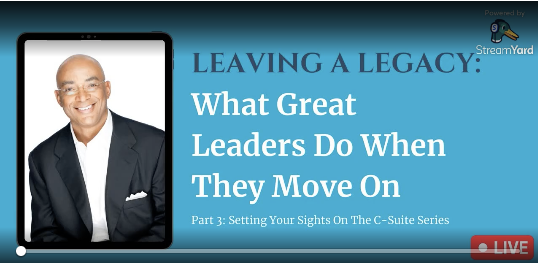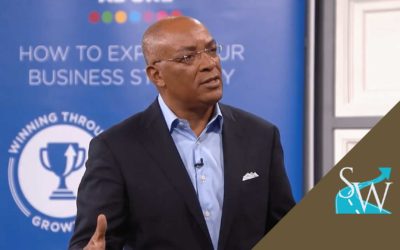Much emphasis is placed on being in the moment. What leaders often forget is how that focus on being present can accumulate over time and create an enduring culture of winning.
You may recall that we talked about how some people believe that you die twice—once when you take your final breath and then again the last time someone says your name. It’s a powerful way to measure your legacy and the impact you had on others by being present.
Today, I’m exploring part three in a series about leadership at the top level. We’ve explored my views on getting to the C-suite and on staying there, and now we’ll unpack leaving there. While I use the C-suite as an example, these principles apply to many levels of leadership.

I’ll start the conversation by asking a question: What if you applied the belief about dying twice to leadership? What if, instead, you looked at your post as a chance to lead twice? In other words, your first leadership tenure is the time you serve others in your position, and the second is the legacy that lives on.
When people tell me that they still think about practices I’ve encouraged or approaches I instilled in them long after I left my leadership position, it’s the greatest compliment they can give me. It tells me that my legacy lives on, that I’m leading twice.
If you are wondering how to inspire the same enduring impression when you’ve had a chance to lead others, it’s about how you lead the first time—in the moment. Let’s face it; no one wants their efforts to be forgotten as soon as they pack up their office. Leading one time isn’t the goal. Instead, if you give your people the skills to sustain them beyond your departure, you’re essentially leading them two times—now and in the future.
Here are three ways you can lead twice:
Create a development culture
A great culture can be your best competitive advantage. As a leader, your job number one is to develop a climate that nurtures growth—where people are lifted up by one another and where mistakes are viewed as learning opportunities. Darnell Martin is a perfect example of someone who created a development culture.
You may recall Martin sponsored me early in my career when I needed it most. He was committed to modeling servant leadership, looked for ways to guide my progress, and provided a hand up. I was inspired by what I saw and committed to following his example. Most people who rise through the ranks have sponsors who put their mentees in a position to show their talents. That’s how you break through barriers and demonstrate your skills. I’m grateful to the Darnell Martins in my life and, in return, have done the same for rising leaders who showed promise.
Identify people for your pipeline
Filling your employee pipeline is less about the what and more about the how. First, you have to observe and analyze who’s doing well in your company and why. These are the qualities and values you have to duplicate in your pipeline. Then you begin identifying great people early and often before you need them. Otherwise, you’ll make hiring decisions under pressure rather than choose people who genuinely match what your company’s looking for.
You’ve risen to your position for a reason; you reflect your company’s values. As a result, they’re depending on you to attract employees who are cut from the same cloth. By recruiting great people and grooming them to take your place, your influence will last for years beyond your tenure.
Create clarity around success
Getting on the same page with your boss about what success looks like is the most important thing you can do. Employee recognition guru and author Bob Nelson says, “When you develop goals with your employees, make sure that they are measurable and attainable. There are few things more demotivating to employees than unrealistic goals that cannot be achieved.”
If you’re in alignment with your employees on measurable and attainable goals, not only will their performance meet or exceed expectations in the moment, but their track record also lives on and provides others with an example to follow. What’s more, success breeds success. When new team members join an effort or department that’s historically successful, they’re buoyed by possibility rather than doubt.
Your alignment with employees ultimately creates a winning culture where people feel your positive influence long after you’ve gone. Much like athletes or storied teams experience winning seasons year after year well beyond a coach’s departure, your employees encounter the same “success reserves” when they need to dig deeper for repeated performances.
Leaving a legacy is about leading twice—first by being in the moment for your team and again by teaching them practices that have a lasting impact. If you’ve reached a leadership position, ask yourself if you’ve created a development culture, if you’re identifying great people early and often, and if you provide clarity around what success looks like. By giving your company these three levels of service, you’re not only leading in the moment, but you’re also leaving a lasting impression.
Live your why,
Steve
P.S. If you haven’t downloaded my new discussion guide for Uncompromising, it’s not too late! Visit my website to download your copy and purchase the book.





0 Comments